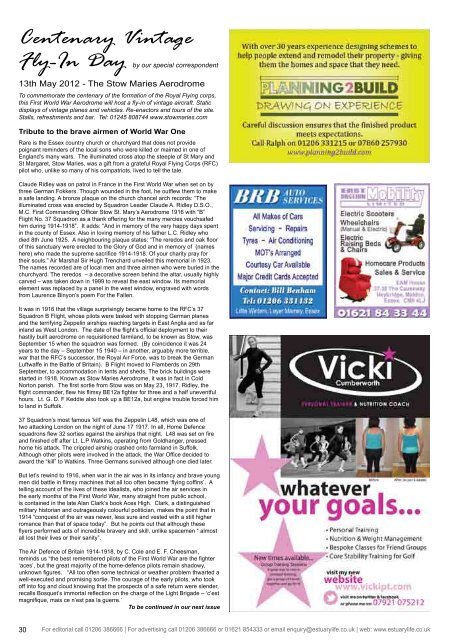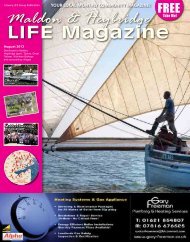TAKE ME! - Estuary LIFE Magazines
TAKE ME! - Estuary LIFE Magazines
TAKE ME! - Estuary LIFE Magazines
You also want an ePaper? Increase the reach of your titles
YUMPU automatically turns print PDFs into web optimized ePapers that Google loves.
Centenary Vintage<br />
Fly-In Day by our special correspondent<br />
13th May 2012 - The Stow Maries Aerodrome<br />
To commemorate the centenary of the formation of the Royal Flying corps,<br />
this First World War Aerodrome will host a fl y-in of vintage aircraft. Static<br />
displays of vintage planes and vehicles. Re-enactors and tours of the site.<br />
Stalls, refreshments and bar. Tel: 01245 808744 www.stowmaries.com<br />
Tribute to the brave airmen of World War One<br />
Rare is the Essex country church or churchyard that does not provide<br />
poignant reminders of the local sons who were killed or maimed in one of<br />
England’s many wars. The illuminated cross atop the steeple of St Mary and<br />
St Margaret, Stow Maries, was a gift from a grateful Royal Flying Corps (RFC)<br />
pilot who, unlike so many of his compatriots, lived to tell the tale.<br />
Claude Ridley was on patrol in France in the First World War when set on by<br />
three German Fokkers. Though wounded in the foot, he outfl ew them to make<br />
a safe landing. A bronze plaque on the church chancel arch records: “The<br />
illuminated cross was erected by Squadron Leader Claude A. Ridley D.S.O.,<br />
M.C. First Commanding Offi cer Stow St. Mary’s Aerodrome 1916 with “B”<br />
Flight No. 37 Squadron as a thank offering for the many mercies vouchsafed<br />
him during 1914-1918”. It adds: “And in memory of the very happy days spent<br />
in the county of Essex. Also in loving memory of his father L.C. Ridley who<br />
died 8th June 1925. A neighbouring plaque states: “The reredos and oak fl oor<br />
of this sanctuary were erected to the Glory of God and in memory of (names<br />
here) who made the supreme sacrifi ce 1914-1918. Of your charity pray for<br />
their souls.” Air Marshal Sir Hugh Trenchard unveiled this memorial in 1923.<br />
The names recorded are of local men and three airmen who were buried in the<br />
churchyard. The reredos – a decorative screen behind the altar, usually highly<br />
carved – was taken down in 1999 to reveal the east window. Its memorial<br />
element was replaced by a panel in the west window, engraved with words<br />
from Laurence Binyon’s poem For the Fallen.<br />
It was in 1916 that the village surprisingly became home to the RFC’s 37<br />
Squadron B Flight, whose pilots were tasked with stopping German planes<br />
and the terrifying Zeppelin airships reaching targets in East Anglia and as far<br />
inland as West London. The date of the fl ight’s offi cial deployment to their<br />
hastily built aerodrome on requisitioned farmland, to be known as Stow, was<br />
September 15 when the squadron was formed. (By coincidence it was 24<br />
years to the day – September 15 1940 – in another, arguably more terrible,<br />
war that the RFC’s successor, the Royal Air Force, was to break the German<br />
Luftwaffe in the Battle of Britain). B Flight moved to Flamberds on 29th<br />
September, to accommodation in tents and sheds. The brick buildings were<br />
started in 1918. Known as Stow Maries Aerodrome, it was in fact in Cold<br />
Norton parish. The fi rst sortie from Stow was on May 23, 1917. Ridley, the<br />
fl ight commander, fl ew his fl imsy BE12a fi ghter for three and a half uneventful<br />
hours. Lt. G. D. F Keddie also took up a BE12a, but engine trouble forced him<br />
to land in Suffolk.<br />
37 Squadron’s most famous ‘kill’ was the Zeppelin L48, which was one of<br />
two attacking London on the night of June 17 1917. In all, Home Defence<br />
squadrons fl ew 32 sorties against the airships that night. L48 was set on fi re<br />
and fi nished off after Lt. L.P Watkins, operating from Goldhanger, pressed<br />
home his attack. The crippled airship crashed onto farmland in Suffolk.<br />
Although other pilots were involved in the attack, the War Offi ce decided to<br />
award the “kill” to Watkins. Three Germans survived although one died later.<br />
But let’s rewind to 1916, when war in the air was in its infancy and brave young<br />
men did battle in fl imsy machines that all too often became ‘fl ying coffi ns’. A<br />
telling account of the lives of these idealists, who joined the air services in<br />
the early months of the First World War, many straight from public school,<br />
is contained in the late Alan Clark’s book Aces High. Clark, a distinguished<br />
military historian and outrageously colourful politician, makes the point that in<br />
1914 “conquest of the air was newer, less sure and vested with a still higher<br />
romance than that of space today”. But he points out that although these<br />
fl yers performed acts of incredible bravery and skill, unlike spacemen “ almost<br />
all lost their lives or their sanity”.<br />
The Air Defence of Britain 1914-1918, by C. Cole and E. F. Cheesman,<br />
reminds us “the best remembered pilots of the First World War are the fi ghter<br />
‘aces’, but the great majority of the home-defence pilots remain shadowy,<br />
unknown fi gures. “All too often some technical or weather problem thwarted a<br />
well-executed and promising sortie. The courage of the early pilots, who took<br />
off into fog and cloud knowing that the prospects of a safe return were slender,<br />
recalls Bosquet’s immortal refl ection on the charge of the Light Brigade – ‘c’est<br />
magnifi que, mais ce n’est pas la guerre.’<br />
To be continued in our next issue<br />
30 For editorial call 01206 386666 | For advertising call 01206 386666 or 01621 854333 or email enquiry@estuarylife.co.uk | web: www.estuarylife.co.uk

















